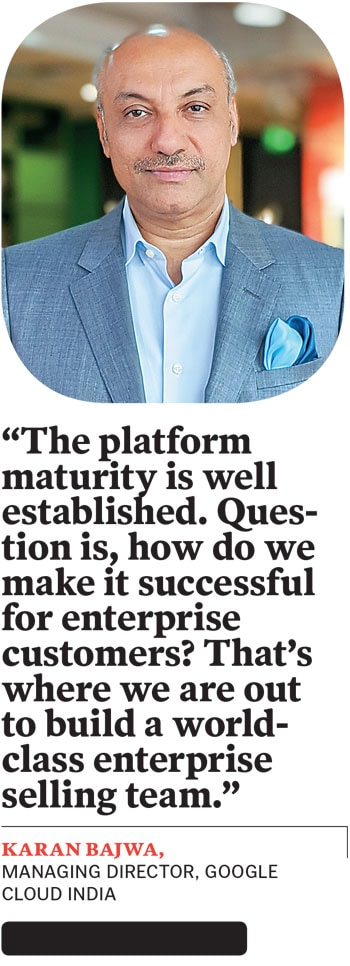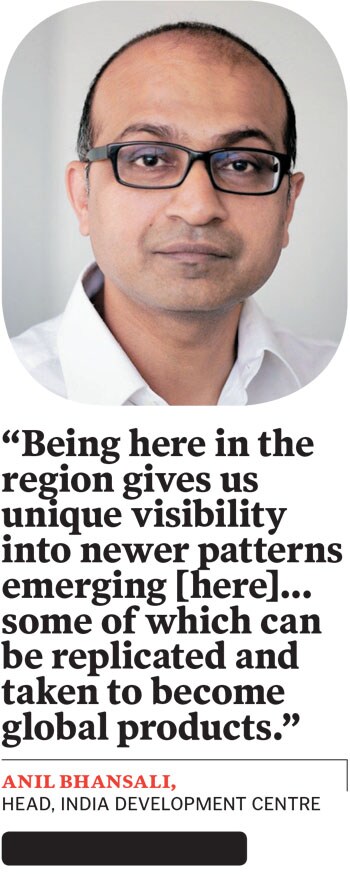And because Google’s services are synonymous with scale, enterprise customers know they can trust the company’s solutions, says Karan Bajwa, managing director, Google Cloud India. Google’s cloud platform is the basis for nine of its services—such as Gmail and YouTube—that have over 1 billion users each. They run on Google Cloud, and that gives credibility to the platform. Google now wants to take that capability to enterprise customers in a much bigger way than before. “The platform maturity is something that is very well established. The question is, how do we make it successful for enterprise customers?” Bajwa says. “And that’s where we are out to build what I would call a world-class enterprise selling team.”
The company has been investing on two fronts in India. One has been in people, building a top-tier leadership and technical team, and the second in partnerships with companies that can help sell and expand the reach of Google Cloud solutions. “We’ve been hiring great talent and putting them in front of customers, and there are investments happening across the world,” adds Bajwa.
Anil Bhansali, who came from Microsoft about four months ago, for instance, is tasked with leading Google’s engineering work as vice president, and heads the company’s India Development Centre. One of its main goals is to build an R&D centre in India over the next few years, he says.
This will help implement a three-pronged effort: One, build expertise to help accelerate the development of Google’s global products two, help Google’s global customers with their operations in India and the region, and to help accelerate their adoption of the Google Cloud Platform and third, “being here in the region gives us unique visibility into newer patterns that are emerging [here]… some of which can be replicated and taken to become global products”, says Bhansali.
Related to this, Google Cloud will also expand its relationships with India’s academia and developers, which is the second largest in the world. “We will look at how we can excite them towards the Google platform, help build their competencies, engage with independent services providers, startups and so on,” he adds.
Bhansali says that over the next couple of years, more than 70 to 75 percent of enterprises worldwide will be adopting a cloud strategy in one form or the other—it could be a multi-cloud approach or a hybrid-cloud option. In this new world, enterprises wouldn’t be interested in spending time and effort in managing their infrastructure or operational efficiencies. They would much rather focus on being more data-driven, on what matters to them for their businesses, and manage their costs.
This ties in with what Google is trying to do with its cloud platform. “Our goal is to accelerate every organisation’s ability to transform through data-powered innovation with the best infrastructure, the best platforms and the best industry solutions. We are bringing all the expertise and experience we have gained over the years in building large services back into Google Cloud,” Bhansali says. Google currently has a data centre region in Mumbai, and in March the company announced it will be opening a second one, in Delhi.
People & partnerships
Cloud computing is a technology-oriented selling engagement, compared to selling a product, and that’s where engineering and technology teams come together to support customers, says Bajwa. Two months ago, Google named Anil Valluri from NetApp as director of Google Cloud. More recently it announced the appointment of Mitesh Agarwal, who came from Oracle, as the director of customer engineering. Google also recruited Priyadarshi Mohapatra, who was previously the head of the consumer business at Microsoft India. “We have a very strong leadership team and we are ramping up on the people front,” Bajwa says.
He also gives examples of partnerships that Google Cloud is getting into. A recent example is the deal with Deloitte in the area of workplace transformation. Google and Deloitte are extending their global alliance to India to help customers modernise and accelerate their adoption of cloud computing. Google has partnered with NTT Netmagic, where the latter will be providing end-to-end Google Cloud services and support to customers—from planning and deployment to migration, security and so on. Google has tied up with Bengaluru-based Wipro for the IT services company to adopt Google’s platform for its own SAP migration to the cloud Wipro itself is also a strong partner, selling Google Cloud services. To address mid-sized companies and the SMB market, Google has partnered with Bharti Airtel for the latter to sell Google’s solutions.
“Accelerating through partnerships is one of the pillars of Google’s strategy,” says Bajwa. The company has a pretty widespread presence among enterprise customers, affecting their businesses, and engaging with their marketing functions as they acquire new customers, he adds.
![karan bajwa karan bajwa]()
The company is bringing “the power of One Google” to Indian clients. While each component brings its own convenience—be it Anthos or the G Suite business and office productivity applications set—it’s the entirety of the solution that makes a difference. Starting from sales force automation, to IT and business functions.
Just as Bhansali is building the engineering team, Google is also building a technical support team for global customers, but that will “automatically give a lift to Google Cloud India customers as well”, says Bajwa.
All these capabilities coming together—technology, team and partnerships—are giving Google Cloud India strong momentum.
Customer categories
When it comes to adopting cloud computing, both Google’s customers as well as companies in general can be put into two categories. One, those who are digital natives and who have taken to cloud computing as the first means of adopting technology and then there are the traditional, large enterprises.
For the first category—usually customers who are already using some form of the cloud model—concerns are around having a multi-cloud strategy, focussing on both optimisation of their spending, as well as advanced features and functionality. These customers are looking for a vendor who can provide superior technological support.
An example is a recent win with ShareChat, a large social media platform that was already on the cloud, and then migrated to Google Cloud. “Google Cloud was our cloud partner of choice given its superior technology, secure and high-performing infrastructure, and cost effectiveness. We were also able to build a high degree of trust with Google’s team that made this seamless migration a reality,” said Bhanu Pratap Singh, CTO, ShareChat in a statement in June. Developers want tools that can accelerate and improve the app development cycle. Google’s advanced tools and integrated solutions like Cloud Bigtable, Cloud Spanner and Kubernetes are aligned well with ShareChat’s needs, he added.
Venkatesh Ramaswamy, vice president of engineering at ShareChat, says: “The Google Cloud ecosystem is so simple to use, and yet can help solve complex problems. We made the decision to move and standardise on Google Cloud because we believe this will help us build better future technologies.”![server rows server rows]() Google currently has a data centre region in Mumbai and, in March, the company announced it will be opening a second one in Delhi
Google currently has a data centre region in Mumbai and, in March, the company announced it will be opening a second one in Delhi
Images: Courtesy Google Cloud[br]Online travel company Cleartrip is another recent example, where it moved from their own physical data centre to the cloud. Their rationale was that the migration was a big architectural advantage for them. They are now able to scale up or down capacity in line with business needs.
IT services company Tech Mahindra is both a partner, selling Google cloud services, and an end-user, tapping Google cloud for its own operations. Ather Energy in Bengaluru is building its next generation connected scooter and digital mobility platform on Google Cloud.
Worldwide, about 20 to 25 percent of actual IT workload is on the cloud today. That proportion in India is likely to be lower. On the other hand, the footprint of digitisation in the country is massively increasing. Customers who are on-premises are clearly looking at options to migrate to the cloud, Bajwa says.
This is where the second category of companies comes into play. It is in this category that many large companies in India fall. In traditional businesses, technology usage has, up until now, been minimal and tiered—with different users having different levels of access to tech, based more than anything on cost. This is because in the traditional model of buying technology and equipping a workforce with it, the entry barrier is high because of prohibitive costs. Cloud computing does away with that. “You pay for what you use, and the colour of money changes. It becomes op-ex,” says Bajwa.
As these large companies emerge from the Covid-19 crisis, they will be keenly looking at every rupee. Money will be spent on the core businesses and yet they will need to spend more on technology. “While digital was part of the strategy earlier, in most cases digital is the strategy now,” he says.![anil bhansali anil bhansali]() Cloud’s cost advantage
Cloud’s cost advantage
How will companies manage spending on their core businesses and technology? This is where what Bajwa calls the “consumption model” comes very handy. It is what cloud computing is really amenable to—for companies to start small and ramp up fast, depending on their operational needs, rather than commit large sums of cap-ex up front. Therefore, while the overall spending can go up, the entry barrier is much lower in the case of cloud computing. Therefore, Bajwa expects bolder adoption of cloud as his customers look at digitalising their business operations.
As they head out of Covid-19, these large companies will accelerate their adoption of cloud computing. Google Meet, a videoconferencing solution, is a very clear example of this. When companies were hit by the pandemic’s repercussions, they had to move to complete work from home. This was an eye-opener, and many companies were caught off-guard. Google offered Meet free of cost to both individuals and companies for some time, which gave people the ability to collaborate. “There are about 6 million companies paying to use G Suite, and some 120 million students and teachers using Google Meet.”
“Like other global hyper-scalers, Google Cloud is investing in the Indian market to exploit its opportunities,” says Naveen Mishra, senior research director at Gartner, which advices corporations on their business technology strategies. In addition to their traditional strength in team collaborations, Google cloud is helping Indian enterprises in areas such as infrastructure modernisation, multi-cloud, analytics and artificial intelligence, he says. “With Covid-19, Indian enterprises are actively investing in digitalisation for ensuring their survival, while conserving their cash.”
In addition to supporting work-from-home and business continuity, cloud computing is becoming foundational for various digital initiatives. India’s public cloud-computing market is expected to touch $9.8 billion by 2025. This is driving ongoing investments by various global and Indian cloud service providers, despite sluggishness in many other areas of IT spend.
Between 75 and 80 percent of the IT workload of companies are still on their own data centres and servers. “This tells you about how the journey has started and how much there is to do, and also indicates the potential and maturity of the market,” says Mishra. It is surely a multi-cloud journey, especially for organisations that are already cloud-native. Companies serious about moving to the cloud are thinking about multi-cloud environments and vendor lock-ins. And costs are obviously an important factor.
The many steps to adoption
Companies with large legacy IT infrastructure are considering hybrid clouds and this is where Kubernetes and Anthos come into play. Kubernetes, originally designed and built by Google engineers, is now a larger open source effort with a multitude of participants. It helps organisations run what are called containers on the cloud. And containers are self-sufficient packages of software applications, engineered to work on cloud infrastructure. Anthos helps customers move to the cloud at their own pace.
A big-bang move to the public cloud environment isn’t going to happen, Bajwa says. The capabilities for modifying legacy applications for the public cloud environment don’t exist. ‘Public cloud’ refers to the pure renting model of storage and computing requirements from vendors such as Google or Microsoft or Amazon Web Services. In contrast, there are ‘private clouds’ that are owned in some form or other by the user-company itself, and ‘hybrid clouds’ that are a combination of private and public options, depending on workload and software applications. The hybrid model is the most popular option currently, as many large corporations have a lot of existing IT infrastructure that they can’t just throw away.
Customers will also want to use cloud infrastructure from different vendors, but still look for a single pane of management. Anthos is 100 percent software-driven and gives companies the ability to manage multi-cloud environments—including their own data centres—through one dashboard.
One important change to note, says Bajwa, is that the consumption models of technology have become mature. Compared to the model of buying hardware and software upfront, companies can now install virtual machines and easily tap into artificial intelligence, machine learning, data management, and various platforms, and pay as they use. In this context, partnering with customers will rise, versus selling them tech upfront.
Artificial intelligence and data analytics will also come of age and push digital technologies to the fore of businesses from earlier being only business enablers. And the pandemic is accelerating this transition.
Google builds services for scale. They are usually always aimed at global applications, while a specific country or market might offer some particular conditions in which to build and test a technology initially. It’s a basic philosophy at the company to innovate locally and scale globally.
The telecom market in India is a good example of how things are changing. In just under two years, data consumption shot up tenfold. It demonstrates the kind of appetite there is in the Indian market for digital technologies. As the government digitalises more of its services, it will add impetus to the trend in the country.
There will be an explosion of adoption of digital technologies in the coming years in India. And Google Cloud India plans to be in the thick of it.

 Illustration: Chaitanya Dinesh Surpur[br] Google’s cloud-computing business has been accelerating its push for enterprise customers, especially with milestones such as Anthos, a sophisticated all-software cloud services management platform that the search giant released last year. Google Cloud India, too, has been ramping up its business. It has garnered customers across a spectrum of companies and verticals, from large established corporations such as Bharti Airtel, India’s second biggest wireless provider, to up-and-coming startups such as Bengaluru’s Ather Energy, which makes connected electric scooters.
Illustration: Chaitanya Dinesh Surpur[br] Google’s cloud-computing business has been accelerating its push for enterprise customers, especially with milestones such as Anthos, a sophisticated all-software cloud services management platform that the search giant released last year. Google Cloud India, too, has been ramping up its business. It has garnered customers across a spectrum of companies and verticals, from large established corporations such as Bharti Airtel, India’s second biggest wireless provider, to up-and-coming startups such as Bengaluru’s Ather Energy, which makes connected electric scooters.

 Google currently has a data centre region in Mumbai and, in March, the company announced it will be opening a second one in Delhi
Google currently has a data centre region in Mumbai and, in March, the company announced it will be opening a second one in Delhi Cloud’s cost advantage
Cloud’s cost advantage